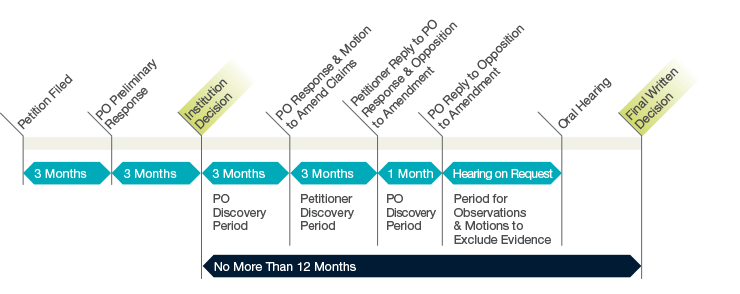Post grant review is an administrative proceeding conducted by the Patent Trial and Appeal Board (PTAB) at the U.S. Patent and Trademark Office to review and determine the validity of an issued patent. Post grant review was introduced by the America Invents Act (AIA) as a counterpart to review. Together, they collectively replace inter partes reexamination, with post-grant review being available immediately after patent issuance, and inter partes review becoming available only after the period for post-grant review has passed.
Patent Office Proceedings
Post Grant Review
As of September 16, 2012 post-grant review became available for covered business method patents regardless of their priority date. For technologies other than covered business method, post-grant review is only available for patents with a priority date later than March 15, 2013
Several aspects of post-grant review are designed to allow the proceedings to conclude quickly. Chief among them are AIA provisions that compel completion of post-grant review proceedings within one year of their commencement, or within one year and six months if the Director can show sufficient cause.
To invoke post-grant review, a challenge must be filed within nine months of a patent’s issuance (or reissuance), establishing that at least one challenged claim is more likely than not to be found unpatentable, or that the request raises a novel or unsettled legal question that is important to other patents or patent applications. During that time, a third party may request a post-grant review of one or more claims, so long as the request is filed before that third party initiates a declaratory judgment action alleging invalidity of a claim of the patent. Counterclaims and post-grant review are deemed independent, leaving the third party free to pursue concurrent invalidity counterclaims and district court litigation regardless of timing.
Post-grant review contemplates several litigation-like aspects, such as limited discovery, protective orders, and settlement.
Post grant review proceedings are generally concluded in no more than 12-months of the Institution Decision. The procedural schedule for a post grant review proceeding is:

Inter Partes Review (IPR)
Inter partes review (IPR) is an administrative proceeding conducted by the Patent Trial and Appeal Board (PTAB) at the U.S. Patent and Trademark Office to review and determine the validity of an issued patent. IPR was introduced by the America Invents Act (AIA) as a counterpart to post-grant review. Together, they collectively replace inter partes reexamination with inter partes review, becoming available only after the period for post-grant review has passed.
Inter partes review proceedings frequently occur in parallel with patent litigation to resolve patent validity issues. Clients have also used inter partes review to resolve licensing disputes and to invalidate patents posing an infringement risk.
Inter partes review is a procedure to challenge the validity of patent claims based on patents and printed publications. Inter partes review can be initiated immediately following issuance (or reissuance) of patents examined under the first to invent rules (i.e., patents filed prior to March 16, 2013), since post-grant review is not available for these patents.
For patents examined under the AIA first to file rules (i.e., patents filed on or after March 16, 2013), inter partes review can be initiated after the nine-month window of eligibility for post-grant review. In other words, for patents that were filed on or after March 16, 2013, post-grant review is the mechanism for challenging the validity during the nine-month window immediately following patent issuance while inter partes review is the mechanism for challenging the validity after the nine-month window.
Inter partes review are generally concluded in no more than 12-months of the Institution Decision. The procedural schedule for an inter partes review proceeding is:

Covered Business Method Review
Covered Business Method (CBM) patents are patents that claim a method, apparatus, or operation used in the practice, administration, or management of a financial product or service. CBM patents do not include patents for “technological inventions,” which are those patents that claim a novel and unobvious technological feature that solves a technical problem using a technical solution. Technological patents will be identified on a case-by-case basis.
CBM review is similar to post-grant review, but there are notable differences between the two. For example, only a party charged with infringement of a CBM patent can initiate a CBM challenge, although under the final rules, a party that has been served a cease and desist letter is likely to be considered to have been charged with infringement for purposes of petitioning for post-grant review of a CBM patent. Additionally, CBM review can be filed only when post-grant review is unavailable (e.g., nine months after issuance). And the prior art available for CBM review of a patent granted under the first-to-invent rules (i.e., patents filed prior to March 16, 2013) is limited to that defined in section 18(a)(1)(C) of the America Invents Act. CBM review also includes unique estoppel provisions that are less extensive than post-grant review. Specifically, estoppel under CBM review extends only to grounds actually asserted but not to grounds that reasonably could have been asserted.
The procedural schedule for a CBM proceeding is:



